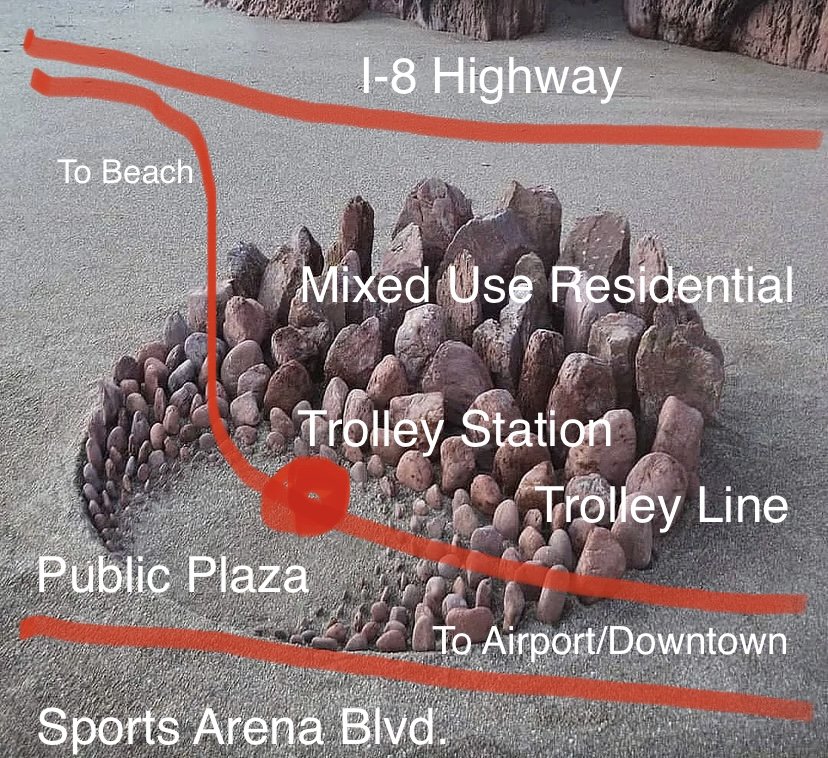The San Diego Sports Arena Site
The site of the existing Sports Arena is one of the most coveted in the city. Although there is some opposition related to an increase in the current height limit, the site has most of the positive attributes you could imagine.
The site has a huge scale to accommodate density. It is surrounded by a large commercial district with close highway access.
The negative is a lack of light rail public transit. I have seen renderings from the various teams and I did not see one that mentions the incorporation of a future light rail expansion that could potentially reach the beach communities.
I understand that developers are connected to financial concerns and architects are grounded by client service responsibilities, however, the lack of integrating efficient public transit at the schematic level is problematic.
It is not a secret that some people have a strong dislike for developers and architects. Maybe it is due to the lack of total vision in the city building process. Personally, I see myself as more than an architect: I am a city builder. Sure, one could discount me or the scale of my budding company as an irrelevant one man show, but my forward thoughts of urban mobility in the built environment is what matters to me.
I understand why architects might feel suppressed or stunted in the expansiveness of their ideas. The industry is highly competitive and there are many entities ready and willing to serve. If architects are not thinking about the built environment of efficient cities in its totality, then who is?
Are developers the key to unlocking the transformation of our rigid city design process? I believe that to be true. Developers and architects need some sort of vision to take a bare plot of land and create constructed form out of nothing. Planners are not as keen to that capability since much of their focus is on functionality generated and measured through prediction and data.
The largest challenge we face is industry specialization which separates the key leaders and place makers. Even though it seems like there is massive coordination occurring, the projects proposed shows there to be little. Private developers and public authorities meet but only to discuss proposals based upon existing guidelines derived from planning strategies and community discourse.
If I could go back in time in San Diego, I want to be at a time when John Sprekels, the rail builder and Alonzo Horton, The Godfather of Downtown San Diego, sat at a dinner table discussing their plans and possible connectivity.
I believe there is a way to get back to that time. There must be a way to get developers thinking forward beyond their own projects. There must be a away to get public authorities and transit planners in that same room, not as regulators, but as listeners and accommodators. We need to get state and federal authorities at that table too. It is imperative that we here the ideas at one time. Who better to give that pitch than a savvy city thinking developer that understands all aspects of the built environment and transit.
This is my concept for the Sports Arena Project Site inspired by a beautiful set of stacked rocks on the beach.
The rocks are a conceptual representation of the built form. The rocks contain the sports arena (either renovated or rebuilt) and the mixed use commercial and residential development. The central space is the public plaza and light rail station.
I am a full service development, architecture, and contracting company. We will work together to excavate a linear section and station box which will be integrated within a parking structure. The linear section for rail transit will be just below the surface and covered with concrete panels. Space will be set aside for ventilation shafts and fire egress to ground level. The excavation will be similar to the tunnel at San Diego State University station, but the work will be performed from the surface down, rather than mined.
Working in this way allows us to simultaneously install critical utilities that typically comes at huge expense when required to return later to integrate rail transit. I see this as a next generation public/private partnership.
Tremendous savings are available due to the mobilizations of the workers and equipment. Digging a trench is not that expensive when the trades are already there performing work. It is expensive when utilities, roads, and other infrastructure needs to be temporarily moved or relocated. There is also additional costs for safety measures and public disruptions. All this can be solved by getting in there and doing it now.
San Diego’s regional government is currently working through their 160 billion dollar future regional plan. If one percent ($1.6 billion) was allocated towards one or two future “integrated” projects, we could solve many existing transit related problems and provide future access.
Additionally, bringing in the State and Federal government at this stage puts San Diego on the map nationally. We are a smaller metropolitan area and we need to be able to compete for funding capital with cities like Los Angeles and New York. If we bring forth a program that is semi-privatized like cities in Asia, we can have the spotlight shed on us and attract government capital so we can get multiple projects rolling simultaneously. That should be our goal and marker of success. When San Diego can two Blue Line type projects going on, then we know we have entered a new era of transit.
I believe that we can accomplish this. These are the types of things that I dream of. It is ironic to me that the once angry young person sitting in the back of the bus became someone that understands the critical value of transit. I embrace that storyline. In life, it is sometimes those strange yet natural occurrences that are placed in the world to generate the change necessary to create a new future.
